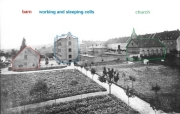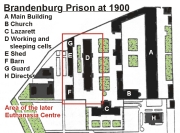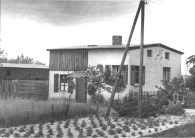During
1790, a home for poor people was founded in Brandenburg (near
Berlin). From
1820 on, the complex of
buildings was extended and then used as a prison. In
1931 the
Brandenburg prison was closed because a new one was built in
Brandenburg-
Görden.
From 24 August 1933 until 2 February 1934
the Nazis used the buildings as concentration camp and police
barracks. Up to 1,200 prisoners were locked up in the cells. Until
1939 some buildings were converted into a euthanasia killing
center. Its term:
Landespflegeanstalt Brandenburg a. H. (on
the river Havel). The location: In the centre of the city!
A gas chamber (3x5 m) was installed in the former brick barn.
The exact location of the gas chamber is unknown because only the
foundations of the barn still exist. From the adjacent former
storage building only the floor is still to be seen. The cells for
working and sleeping do not exist anymore and only its foundations
were discovered in
1996.
The killings took place in the same way as in the other euthanasia
centres: Buses brought the victims to the site where they were
registered, undressed, examined and gassed. In Brandenburg the gas
chamber also looked like a shower bath where carbon monoxide was
used for gassing. The bodies were cremated in two mobile cremation
ovens at night. The crematory could have been situated in the
adjacent building or near the former church. Since
July 1940 the
corpses were cremated outside the town at
Paterdamm street. The site was
disguised as
Chemisch-Technische Versuchsanstalt (Chemical
and Technical Research Institute).
The first killing took place in
January 1940 when 18 to 20
insane criminals were gassed in this test, which contributed to the decision to
use carbon monoxide gas for killing. Among several doctors from the
T4 staff, the following persons were present: Dr
Brandt
(
Hitler's personal doctor), Dr
Conti
(
Reichsärzteführer),
Philipp Bouhler (
Reichsleiter /
Chief of
Hitler's Chancellery) and Dr
August Becker (chemist and
supplier for the gas cylinders). This gassing was carried out by
Christian Wirth, who played a prominent role in the mass
extermination program in the
Generalgouvernement (Poland), called
Aktion Reinhard.
The last killing took place on
29 October 1940. Children from the
mental home in Brandenburg-
Görden were murdered.
More than 9,000 persons lost their lifes in the Brandenburg
euthanasia centre within nine months. Among the victims were more
than 400 Jews.
After the stopping of the euthanasia program the buildings served
as a prison, accomodation for forced labourers and police barracks.
During the war some buildings were destroyed and demolished after
1945. More traces of these crimes were lost when new buildings were
constructed on the site.
Finally on
27 April 1997 the Brandenburg memorial was opened, but
further research is needed to uncover the exact history of this former killing site.
A number of
Aktion Reinhard personnel served at
Brandenburg, these include
Rudolf Bär, Kurt Bolender, Kurt D.,
Werner Dubois, Irmfried Eberl,
Kurt Franz *,
Erich Fuchs, August Hengst, Willy Mätzig, Josef Oberhauser,
Karl Pötzinger, Friedrich Tauscher, Max Biala and Christian Wirth.
* See the Franz Photo Story!















